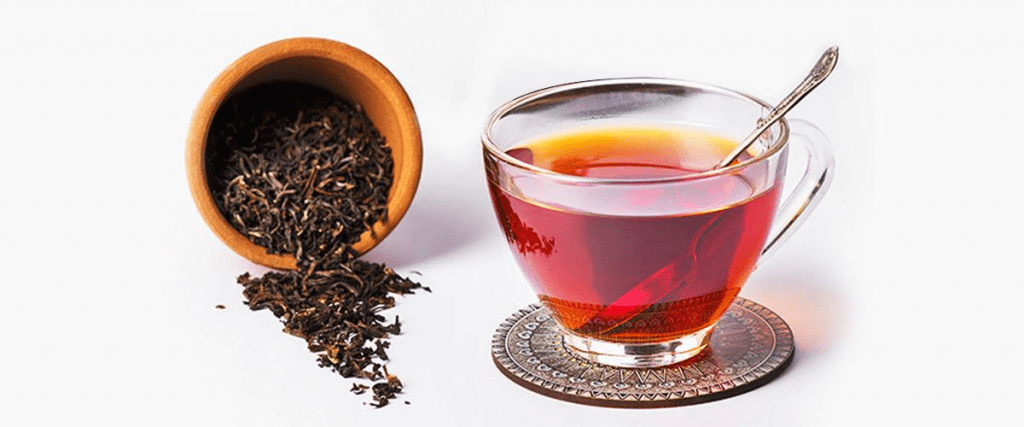Way back in the second millennium, when the Shang dynasty first began to develop a medicinal drink to soothe their ills, little did they realize they were brewing the prototype of a beverage that would become the second most consumed liquid after water – tea. Black tea, a popular variant, is the most oxidized among its brethren. Black tea is perhaps an accidental discovery in the history of tea, resulting from the over-oxidization of green and white teas. In terms of popularity, most of the tea (around ninety percent, in fact) sold in the West is black. Black tea has a robust flavor compared to the milder, more subtle taste of teas such as oolong. And unlike green tea, black tea does not risk losing any of its flavors for quite a few years, making it relatively easy to store. Popular variants of black tea include the Lapsang souchong from China’s Wuyi Mountains, the renowned Darjeeling tea from India’s tea gardens of West Bengal, and the legendary Ceylon tea from Sri Lanka, to name a few.
A brief history of black tea
As with all types of tea, black tea’s origin can be traced back to the northeastern stretches of Asia. Oral traditions provide records of the tea being consumed in China as far back as the mid-seventeenth century. Gongfu, a prototypical version of the beverage, was being produced by tea makers in the Wuyi Mountains of China’s Fujian province. They would knead the leaves already dried out in the sun and then leave them out in the sun again, thus oxidizing them fully. However, the story of a Chinese army passing through this region details an account of the creation of black tea’s most distinct early variants – Lapsang souchong. Once an army had crossed over into Fujian from Jianxi and had made camp at a tea-making facility, it is said that causes a delay in gathering the leaves left in the sun outside. Alarmed at the resultant dark redness of the leaves and fearing they would no longer be of use, the tea maker placed the leaves over a large pinewood fire to dry them faster. This smoky, flavorsome beverage became known as Lapsang souchong. Afterward, the general tendency of black tea to not spoil for long periods made it an ideal trade commodity in the colonial era, as the British would ship the beverage across the seven seas to Europe. After being denied tea exports from China by the Dutch, the British would find similar strains in India’s Darjeeling hills. In recent times, most of the tea sold in the US has been black.

How one would go about making a cup
Being the most marketed of the tea variants, one would not find it challenging to acquire black tea leaves. Variants of black tea such as Darjeeling, or the more exotic Rize from Turkey, are available amidst various choices. Naturally, it is more beneficial to use leaves than teabags, the former containing more incredible flavor.
No more than two to three grams of leaves should be used for every seven ounces of water (that’s around two hundred milliliters). In terms of volume, a single (rounded) teaspoon is a safe starting bet. If the tea leaves are larger, feel free to make that one to two tablespoonfuls. Exact measurement depends on individual flavor preferences, so a bit of trial and error is advised.
When it comes to how far one should boil the water for the tea, it is preferable at around 208–212 °F, with a bit of good old eyeballing. Unlike green and oolong variants, black tea doesn’t need the water to cool before being added for preparation. The tea should be soaked in the water for around three to five minutes, with the flavor growing more potent the longer it is allowed to steep in the pot. But do be sure not to make it less than three minutes, checking every half minute afterward, to find the taste of one’s liking. However, optimally speaking, it is best to use more leaves for a stronger brew, as leaving it in the pan for a long time results in a more bitter tea, not just strong. But that might even be the point, in case a strong, bitter cup is needed. Strain and pour to drink afterward. Either that or if you have infusers, make sure it gives the leaves room to expand as they unfold, letting out the flavor it contains.
Suggestions on consumption
As aforementioned, the longer the leaves are steep, the more robust and more bitter the flavor. Moreover, the type of black tea being consumed must also be considered – Darjeeling, for example, should not be left in the heat too long lest they lose their vaunted taste. Japanese cold-brewing aficionados will be glad to hear that black can be steeped in cold water as well, straining out the leaves after four to eighteen hours in the refrigerator. Just remember to use around 40% of tea to 60% of water to make sure enough flavor is released.
Iced variations of the tea can also be brewed, but make sure to use double the amount of leaves as you would for a warm cup, with the usual steeping. While slightly lowering the nutritional value of the tea, Milk may be added as per preferences, along with sugar or honey. More astringent varieties may be consumed with milk and sugar to lessen the astringent taste of teas from India or Sri Lanka. Teas from China, however, are smoother in comparison and go well without added milk or sugar.
Some accompaniments, if one prefers
Cinnamon sticks are sometimes excellent accompaniments to black tea, as are meaty and spicy dishes. Thanks to its strong natural flavor, one can pair it with beef, lamb, or even venison. Lasagna, too, incidentally is a great meal to have over a cup of black tea.
More specifically, variants such as Darjeeling go very well with eggs and desserts that use cream, apart from fruits like apricots and cheese. Keemum tea, on the other hand, is ideal to accompany the consumption of red meat and dishes that are spicy. The famous Lapsang souchong can be drunk with chicken, fish (such as smoked salmon or cod), or desserts with lemon. And if it is chocolate that one wishes to drink over, a fine cup of Assam tea fits the bill. The standing rule is that teas with a robust and robust aroma, and those that release tannins entirely, are preferable accompaniments with heavier heartier meals, involving red meat and spices.
Health Benefits of Black Tea
Black tea is an excellent antioxidant. This is due to the presence of polyphenols in black tea, which fights free radicals in the body, delaying oxidization. What this implies is that black tea consumption may help combat the development of plaque in the arteries, known as atherosclerosis, which, in turn, is a prelude to strokes and coronary heart diseases. It is also known to reduce the risks of cancer by restricting tumor growths possibly. The polyphenols are also effective for regulating high diastolic and systolic blood pressure. It can help regulate levels of cholesterol and triglyceride. And not to mention, it provides a much-needed shot of energy at times. And of course, it’s also very low in calories, making tea a good health drink.
Nutrition & levels of caffeine
One hundred grams of black tea contains 20 milligrams of caffeine, which brings it to a milligram of caffeine for every five grams of tea. In contrast, decaffeinated black tea contains only one milligram of caffeine for every hundred grams – a reduction of over ninety percent.
Recipes
Vodka infused with black tea – 750 ml vodka (neutral tasting), 6 tsp black tea (unflavored preferably), and maple syrup, optional. The cocktail ingredient can also be had on the rocks.
- With a funnel, place the leaves within the bottle.
- Close the bottle and shake it thoroughly.
- Allow it to soak for over eighteen hours.
- Run the resultant mixture through the strainer and into a different bottle. If the syrup is to be added, the bottle must contain sufficient space.
- Remove the tea leaves. Add syrup at this point.
Masala chai – 2 cups milk, 2 cups water, 4 cloves (whole), 2 green crushed cardamom pods, 2 peppercorns (crushed), a stick of cinnamon, half an inch of ginger (either peeled & chopped or grated), 2 tablespoons sugar, 2 tablespoons black tea (such as Assam, preferred).
- Within a saucepan of medium size, pour the milk and water and add the spices. Let the pan simmer for ten minutes, with the mixture being stirred occasionally.
- Add sugar and tea. Once more, let it simmer for around five minutes and keep stirring from time to time.
- Strain the liquid from the pan and pour the resulting beverage.
This is a standard recipe for masala chai, and one should be free to experiment. In India, masala chai is made from whole milk, but skimmed or soy milk could be possible alternatives. As far as spices go, contenders include coriander, allspice, tamarind, vanilla, star anise as well as nutmeg.
References
- https://www.hackberrytea.com/blogs/tea-education/the-history-of-black-tea
- https://en.wikipedia.org/wiki/Tea
- https://en.wikipedia.org/wiki/Black_tea
- https://en.wikipedia.org/wiki/Tea_production_in_Sri_Lanka#International_market_and_prices
- https://en.wikipedia.org/wiki/Tea_processing
- https://en.wikipedia.org/wiki/Lapsang_souchong
- https://www.thekitchn.com/how-to-brew-black-tea-cooking-lessons-from-the-kitchn-201670
- https://www.myrecipes.com/extracrispy/the-tea-temperature-trick-that-will-give-you-a-perfect-cup-every-time
- https://www.thespruceeats.com/introduction-to-black-tea-766429
- https://www.arborteas.com/tea-pairings/
- https://www.twinings.co.uk/about-twinings/latest-news-and-articles/food-pairing-with-tea
- https://www.medicalnewstoday.com/articles/292160.php#possible_health_benefits
- https://food.ndtv.com/food-drinks/black-tea-for-weight-loss-3-ways-in-which-the-beverage-helps-burn-fat-1894800
- https://www.thespruceeats.com/black-tea-recipes-764980
- https://www.thespruceeats.com/black-tea-infused-vodka-recipe-766113
- https://www.thespruceeats.com/how-to-make-masala-chai-tea-4134710



